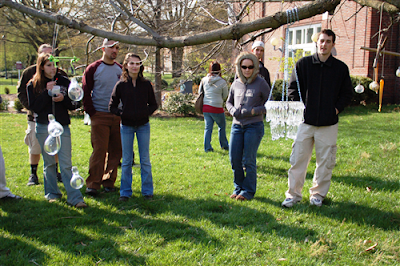>
Author Archives: Betty Py
Georgetown Book Hill Gallery Walk features WGS artists
>
On September 14 from 6-8pm, DC’s Georgetown will have an evening Gallery Walk that will showcase art galleries located on the upper Wisconsin Ave – near Book Hill Park.
 |
| Allegra Marquart “Peacock’s Compliant” |
Maurine Littleton Gallery will feature artwork by local DC-area artists including Allegra Marquart, Michael Janis and Drew Storm Graham at the gallery for the September 14 Book Hill gallery walk event.
 |
| Drew Storm Graham “Dusk” |
 |
| Michael Janis “Eclipse” |
September 14 from 6-8pm
phone: 202-333-9307
Salisbury University Seeks Assist Prof of Art, Glass
>
Assistant Professor of Art, Glass – Faculty Position (10881)
- Current Active SU Employees, please login to GullNet and click “Careers at SU.”
- All others, please click Apply Online.
- See OEAS FAQs (Online Employment Application System FAQs) for help.
| SU’s hot glass workshop, where students learn the art of glassblowing, the only such program in the state of Maryland |
Area of Specialization: Hot Glass and 3D Studio
Primary Job Duties: Teaching three hot glass classes per semester with a total of 18 contact hours of teaching per week. Maintain studio, build and maintain equipment in glass, and implement and adhere to safety protocols. Program development for glass, active recruitment of majors, advisement, and departmental committee work are required. Utilize effective teaching and classroom management strategies which enhance the success of diverse learners.
Minimum Qualifications: MFA with an emphasis in hot glass. Preference will be given for prior teaching experience and an active exhibition record.
Applications will be accepted via Salisbury University’s Online Employment Application System. Please visit our website http://www.salisbury.edu/HR/Jobs/ to apply online. See the FAQs of the Online Employment Application System for more information and instructions.
To be considered an applicant, you must apply online and submit the following: letter of application, CV, two sample syllabi and a statement of teaching philosophy, exhibition record, graduate and undergraduate transcripts (copies accepted), and the names and contact information of at least five (5) professional references. All other documents that you wish to provide must be attached to your application in the Online Employment Application System. Please do not send any other documents via E-mail. If you have any questions about the position, please contact the Jim Hill, at jkhill@salisbury.edu.
Note: Mail CD containing 20 digital images of applicant artwork, and 20 images of student work with size, dates and media of each piece identified. To the Attention: Salisbury University, Art Department, M K Brown, 1101 Camden Avenue, Salisbury, MD 21801.
Applications submitted by October 22, 2012 will receive first consideration. The position will remain open until filled. Salary is competitive and commensurate with qualifications and experience. Appointment will be contingent upon verification of eligibility to work in the U.S. and is expected to begin August 15, 2013.
This position is based in Salisbury Maryland. Founded in 1925, Salisbury University is one of 13 institutions that compose the University System of Maryland. Salisbury University is a selective undergraduate institution with the University System of Maryland. The Art Department is a vibrant, fast-growing, collegial department with a full-time faculty of 18 artists and one full-time art historian, with possibly a second tenure-track position in Art History in the near future. The University is close to ocean beaches and the Chesapeake Bay and 2-3 hours from the metropolitan areas of Washington, Baltimore, Philadelphia, and Norfolk. SU has been cited nationally as one of the top ten public regional universities in the North according to the U.S. News and World Report, and has also been recognized by the Princeton Review and Kiplingers magazine. SU has 388 full-time faculty members serving a student population of approximately 8,600.
For more information – click HERE to jump to University Job Listing
Bringing Light To The Dark Side
>
Novie Trump is a world renown ceramic artist, working from Flux Studios, located right next door to the Washington Glass School. Her poetic sculptural work often involves depictions of nature – presented in unexpected and captivating ways.
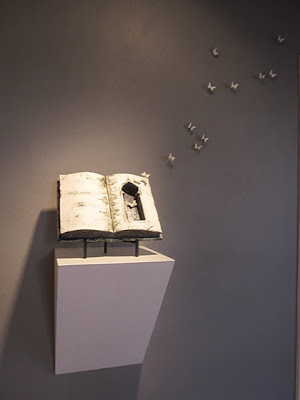 |
| Novie Trump Escape Installation of porcelain butterflies and ceramic book Ceramic, Acrylic Rods, Steel 60” x 60” x 24”(variable) |
Novie is working on a commissioned artwork piece that came to her via Project 4 Gallery: to create large scale installation that will be located in the new Farmers & Fishers restaurant now being built at the Georgetown waterfront.
Her artwork design calls for many porcelain bees to be clustered around illuminated hives are various locations. The design of the beehive has brought her to the glass studio – and it is a chance for the glass artists to bring Novie over to the dark – or rather – the glassy side.
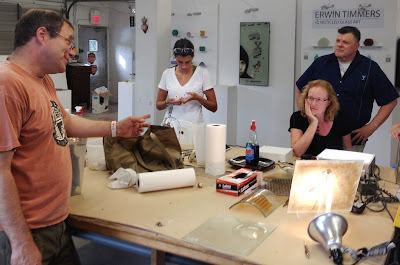 |
| Erwin Timmers offers some adventurous suggestions to Novie, but from the expressions on both her and Tim Tate’s face, they seem unlikely to be incorporated. |
| A sample of Novie Trump’s porcelain bees |
Novie chose to work with illuminated glass – creating a pattern of cellular hive divisions with frit powder fused to glass, and slumped over a tapered form. The WGS fritmaster – Michael Janis – offered Novie some pointers on how to manipulate the powder.
| Novie Trump and Michael Janis share a laugh as they work |
| Novie sifts glass powder onto a sheet of glass |
| Manipulating frit powder is a delicate operation |
| Novie Trump and Michael Janis evaluate the glass’ progress prior to loading the layer in a kiln for firing |
After fusing, the samples are compared by Novie Trump for her preferred selection of color and texture combination |
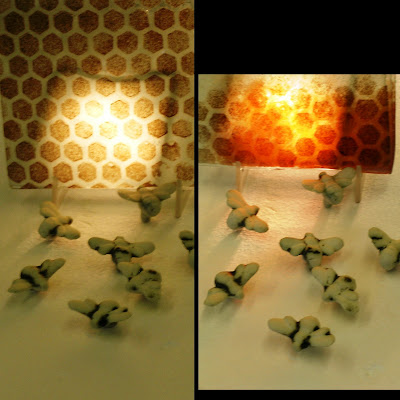 |
| Novie made many studies of the color and textures and tested the samples with light source alternates. |
The Heat Base Lampworking Studio
>
A new lampworking studio has opened in NoVa – the Heat Base. Located in suburban Woodbridge,Va. just off I-95 (near Potomac Mills).
They offer some group class and private lessons.
For more info Contact Robert Kincheloe
email : robert@brvglass.com
Look them up on Facebook
The Heat Base
Drawing On Glass
>
| Nancy Donnelly uses underglaze pencils to create fused glass drawings. |
Working in the glass school, Nancy Donnelly creates fused glass drawings and sketches. Originally a painter, Nancy likes to explore ways to bring her “painterly aspects” into glass. Using underglaze crayons and pencils, Nancy works at getting a loose ‘sketch’ feel into her glass artwork.
| The use of underglaze pencil allows Nancy to retain her detail and her quality of sketch in the art. |
| Nancy likes the expressive qualities of the sketch. |
| Nancy is able to capture the personality of the subject. |
Examples of Nancy’s artwork can be seen in Foundry Gallery in DC’s Dupont Circle neighborhood. Nancy will have a solo show there this coming October 3 – 28th, 2012.
Foundry Gallery, 1314 18th St NW, WDC
Bullseye RCBA Gallery Opens Painterly Glass Exhibit
>Bullseye Glass had earlier this year opened their new facility in the California’s Bay area near the Silicon Valley/Berkely/San Francisco corridor of Emeryville, CA. The place is called Resource Center Bay Area (RCBA) and this facility (the third of BE owned centers) offers workshops, supplies and a gallery.
| RCBA, Bullseye Glass’ new home in California. 4514 Hollis Street, Emeryville, CA |
One of the upcoming exhibits at the RCBA Gallery opens this coming Saturday, Aug 4, 2012. Titled: Facture: Artists on the Forefront of Painterly Glass, a number of the works were shown at BE’s Portland gallery early this year in a show of the same name. The exhibit will showcase kilnformed glass paintings (mostly frit on sheet glass) from the artists Abi Spring, Kari Minnick, Martha Pfanschmidt, Ted Sawyer, Jeff Wallin, and WGS’ Michael Janis.
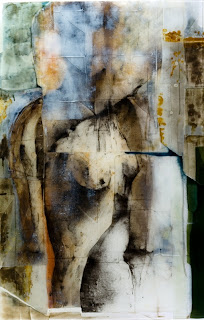 |
|
Jeff Wallin Residue of a Figure Study kilnformed glass |
from the BE website:
Facture: Artists at the Forefront of Painterly Glass is a group exhibition that explores many of the concerns of contemporary painting, but does this exploration with glass. Painting exists in a continuum with centuries of tradition while simultaneously embracing aspects of sculpture, installation and collage. Painting today goes beyond pigment on a surface; it is an approach to image making that encompasses the ways in which a material is used to construct a work, how an artist approaches a subject, and even how an image is conceived. The artists included in Facture are constructing paintings using glass.
 |
|
Michael Janis Observation of Signals kilnformed glass and steel |
Glass, unlike traditional painting materials, is both surface and solid. Value and intensity can be created on the suface as well as volumetrically. Paintings made from glass are image and object; illusion and reality, and these artists, at the forefront of this young method, are scratching at the boundaries of both.
 |
|
Martha Pfanschmidt Last Year kilnformed and coldworked glass |
View the exhibition: Bullseye Resource Center Bay Area Gallery, August 4 – October 20, 2012.
Opening Reception: Saturday, August 4, 3–5pm.
Go to map & driving directions
Glass Fun Fact: Prince Rupert’s Drops and Tempered Glass
>
Much of functional architectural glass applications – like shower doors, table tops, car windows, skylights, etc. – requires the use of safety glass – often glass that has through a process called tempering. Glass is pretty wonderful stuff, but it does have some bad habits. First, it is brittle and has a tendency to crack when struck or heated unevenly. Second, shards of glass are really sharp and pretty dangerous. Tempered glass solves both of these problems simultaneously. Glass is much stronger in compression than tension.
Float Glass process
If you can cause the surface of the glass to become compressed relative to the interior of it, you can harden it by a factor of up to 10. There are a couple of ways to do this. One is to heat the glass and then cool it very quickly. The surface of the glass will cool much more rapidly than the interior. The slow cooling of the interior causes it to want to contract more than the surface, placing the surface under considerable compression. This strengthens the glass and makes it more scratch-resistant and heat-resistant in the bargain. Another method is chemical tempering, in which sodium atoms on the surface of the glass are replaced with potassium atoms, which are significantly larger. This also puts the surface in compression, and can be done with glass of complicated shapes that would not survive heat tempering.
 One interesting effect of the tempering process is that tempered glass doesn’t just crack. When tempered glass encounters a big enough stress, it shatters into small granules. If the integrity of the surface of the glass becomes compromised, the interior, which is under huge tension, will disintegrate. This is much safer than big dangerous shards, but does make the glass suddenly an awful lot harder to see through. This is one reason why the windshield of your car is not made with tempered glass, but laminated glass. Laminated glass is made by bonding two or more layers of glass with an ‘interlayer’ of plastic film which will hold the pieces together if the glass should crack.
One interesting effect of the tempering process is that tempered glass doesn’t just crack. When tempered glass encounters a big enough stress, it shatters into small granules. If the integrity of the surface of the glass becomes compromised, the interior, which is under huge tension, will disintegrate. This is much safer than big dangerous shards, but does make the glass suddenly an awful lot harder to see through. This is one reason why the windshield of your car is not made with tempered glass, but laminated glass. Laminated glass is made by bonding two or more layers of glass with an ‘interlayer’ of plastic film which will hold the pieces together if the glass should crack.
Tempered glass is an extremely useful material, but it does demand some planning. Because of tempered glass’ all-or-nothing breakage, it must have been already cut to the size, shape, and already have any holes cut out before the tempering process. There’s no cutting the glass down to fit afterwards.
Tempering as an industrial process started in the 20th century, but it was a party trick far before that. One of the first examples of tempered glass is something called
When you think about it the stuff is a bit odd, but that’s glass for you. It’s odd stuff.
A local DC morning news television station visited Erwin Timmers’ recycled glass art class, and he demonstrated the explosive properties of tempered glass by shattering a thick panel (jump to 2:47).
Click on each line below to jump to previous Glass Fun Facts postings:
Glass Fun Facts: Gaffer/Composer
More Glass Fun Facts: Bullseye Glass
Float Glass Fun Facts
Glass Fun Facts – Shattered Glass Predicts Weather
Why is Glass Transparent?
Glass BLAST! in London
>
 |
| Cate Watkinson |
 |
| Joanne Mitchell |
London, England’s ZeST Contemporary Glass Gallery is hosting BLAST! 2012, the 10th anniversary exhibition of Cohesion Glass Network. Cohesion Glass Network is an initiative supported by the UK’s Sunderland City Council as a way to create a business network for glassmakers and artists.
 |
| Tim Tate |
To celebrate this landmark, ZeST Gallery has invited eight of Cohesion’s founding members to exhibit their latest artworks and provided the opportunity to select an artist to be a “partner” and show work alongside them.
 |
| Roger Tye |
These eight artists are Criss Chaney, Dominic Fonde, Zoe Garner, Ruth Lyne, Joanne Mitchell, Claudia Phipps, Roger Tye and Cate Watkinson. They have selected partners whose work they admire, or find complementary to their own, or in some cases they have joined forces to create unique collaborative work, exploring and developing themes and concepts held in common. Some, but not all, of the partner artists are Cohesion members, and all but one of the partners are artists working in glass.
 |
| Michael Janis |
Cohesion artist Joanne Mitchell chose Washington Glass Studio artist Tim Tate. Cohesion’s Roger Tye is paired with WGS’ Michael Janis. Michael and Tim were both at Cohesion’s studios while in the UK on their Fulbright assignment.
The exhibition features a diverse selection of glass art, including wall-mounted and installation artwork, as well as vessels and sculpture, and embodies a broad spectrum of processes and techniques. The pairings within the show create an exciting dynamic of glass, artistic and otherworldly narratives.
 |
| Carrie Fertig |
Artist pairings include:
Criss Chaney with Robyn Townsend
Dominic Fonde with Chua Teng Yeow
Zoe Garner with Carrie Fertig
Ruth Lyne with Rachel O’Dell
Joanne Mitchell with Tim Tate
Claudia Phipps with June Kingsbury
Roger Tye with Michael Janis
Cate Watkinson with Emma Hollins
Blast! 2012
July 6 – August 8, 2012
Zest Contemporary Glass Gallery
Art, Work, Love and Other Basics
>
Art, Work, Love and Other Basics. A panel presented by The James Renwick Alliance
The artists will be discussing their creative processes, the body of their work, their interests, and their inspiration. FREE and Open to the Public.


